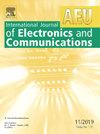Maximizing secure communication in SWIPT-NOMA with SIC and CSI errors
IF 3
3区 计算机科学
Q2 ENGINEERING, ELECTRICAL & ELECTRONIC
Aeu-International Journal of Electronics and Communications
Pub Date : 2025-02-20
DOI:10.1016/j.aeue.2025.155740
引用次数: 0
Abstract
This article investigates the secrecy rate (SR) analysis of a new control-jamming (CJ) assisted SWIPT-NOMA network with decode-and-forward (DF) cooperative relaying subject to a total transmit power budget. Specifically, power-splitting (PS) protocol is employed at the relay for energy harvesting (EH). The harvested energy is utilized for transmitting information to users through a flat-Rayleigh-fading channel. Importantly, the network’s performance is investigated in terms of SR with successive interference cancellation (SIC) and channel-state-information (CSI) errors. To provide a comprehensive analysis, CJ is compared with various jamming conditions, which can secure the wireless transmissions against the eavesdropping. Further, the analytical expression for Ergodic SR is also obtained and confirmed through simulation. Moreover, A Particle swarm optimization (PSO) algorithm is utilized to determine the optimal power distribution among various nodes. The impact of critical parameters like transmit SNR and also the J-to-Eve and R-to-Eve distances on the level of secrecy are also analyzed. Finally, Monte-Carlo simulations validate that at a transmit SNR of 20 dB, the optimal power allocation (OPA) scheme under CJ achieves 12 % and 5 % improvement in SR at users U1 and U2. Additionally, CJ also effectively boost the network’s secrecy over other jamming cases under all CSI and SIC conditions.
在具有SIC和CSI错误的swift - noma中最大化安全通信
本文研究了一种新型控制干扰(CJ)辅助下具有译码转发(DF)合作中继的swift - noma网络在总发射功率预算下的保密性分析。具体来说,在能量收集(EH)中继中采用功率分割(PS)协议。收集的能量被用于通过平瑞利衰落信道向用户传输信息。重要的是,研究了具有连续干扰消除(SIC)和信道状态信息(CSI)误差的SR网络的性能。为了提供全面的分析,对各种干扰条件进行了比较,以确保无线传输不被窃听。此外,还通过仿真得到了遍历式SR的解析表达式。此外,采用粒子群优化算法确定各节点间的最优功率分配。分析了传输信噪比、J-to-Eve和R-to-Eve距离等关键参数对保密级别的影响。最后,蒙特卡罗仿真验证了在发射信噪比为20 dB时,CJ下的最优功率分配(OPA)方案在用户U1和U2处的SR分别提高了12%和5%。此外,CJ还在所有CSI和SIC条件下有效地提高了网络的保密性。
本文章由计算机程序翻译,如有差异,请以英文原文为准。
求助全文
约1分钟内获得全文
求助全文
来源期刊
CiteScore
6.90
自引率
18.80%
发文量
292
审稿时长
4.9 months
期刊介绍:
AEÜ is an international scientific journal which publishes both original works and invited tutorials. The journal''s scope covers all aspects of theory and design of circuits, systems and devices for electronics, signal processing, and communication, including:
signal and system theory, digital signal processing
network theory and circuit design
information theory, communication theory and techniques, modulation, source and channel coding
switching theory and techniques, communication protocols
optical communications
microwave theory and techniques, radar, sonar
antennas, wave propagation
AEÜ publishes full papers and letters with very short turn around time but a high standard review process. Review cycles are typically finished within twelve weeks by application of modern electronic communication facilities.

 求助内容:
求助内容: 应助结果提醒方式:
应助结果提醒方式:


